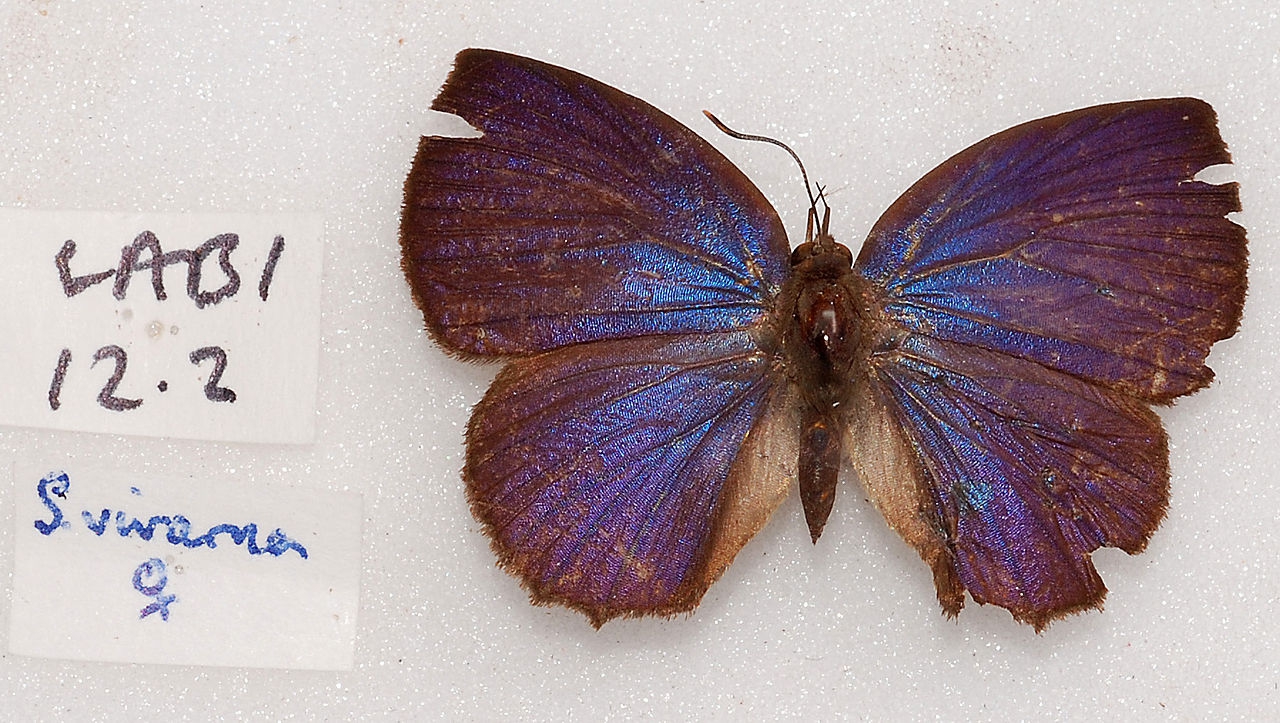| Taxon ID: 3,090 Total records: 39,143 | ||||||||||||||
Amblypodia vivarna
Country
| Country | Brunei Darussalam |
|---|---|
| Continent Ocean | Asia |
Classification
| Kingdom | Animalia (COL) |
|---|---|
| Phylum | Arthropoda (COL) |
| Class | Insecta (COL) |
| Order | Lepidoptera (COL) |
| Family | Lycaenidae (COL) |
Taxonomy
| Genus | Amblypodia | Reference | |
|---|---|---|---|
| SubGenus | Vernacular Name | ||
| Species | vivarna | IUCN Threat Status-Year | Least Concern, 2011 |
| SubSpecies | Nat'l Threat Status-Year | Not Evaluated, 2000 | |
| Infraspecies | Reason for Change | ||
| Infraspecies Rank | CITES | ||
| Taxonomic Group | Insects | Native Status | Native |
| Scientific Name Author | Horsfield, 1829 | Country Distribution | Brunei Darussalam |
| Citation | Description | Geographic Range [top]
Range Description: This butterfly is widely distributed through South East Asia, from India and Sri Lanka through Thailand (Pinratana 1981), peninsular Malaysia, Sumatra, Borneo (Seki et al. 1991), the Philippines (Balabac, Palawan, Calamian group) (Treadaway 1995) and Sulawesi (Vane-wright and De Jong 2003). There are also some instances of this species in China, for example in the Fusui Rare Animal Nature Reserve, south-western Guangxi. This gives the species a very large extent of occurrence (EOO) and the area of occupancy (AOO) is also likely to be fairly large. The species does not occur above 760 m elevation.
Countries occurrence:
Native:
Brunei Darussalam; China (Guangxi); India; Indonesia (Kalimantan, Sulawesi, Sumatera); Malaysia (Peninsular Malaysia, Sabah, Sarawak); Philippines; Sri Lanka; Thailand
Additional data:
? Upper elevation limit (metres): 762
Range Map: Click here to open the map viewer and explore range.
Population [top]
Population: This species is relatively common throughout most of its range (Eliot 1992, W.J. Tennent and C.J. Muller pers. comm. 2009).
Current Population Trend: Unknown
Additional data:
? Population severely fragmented: No
Habitat and Ecology [top]
Habitat and Ecology: This is a shade-loving butterfly inhabiting primary and secondary rainforest. It is most commonly encountered along creeks or in gullies within the forest. Adults generally keep to the undergrowth, where they may remain inactive for long periods (Igarashi and Fukuda 2000). It is reported to rely on the ant species Anoplolepis gracilipes (Megens et al. 2004) and larvae feed on Albizia falcate plants. The species is sexually dimorphic.
Systems: Terrestrial
Threats [top]
Major Threat(s): This species is not under any major threat. However, Cleary et al. (2004) and Hirowatari et al. (2007) found that this species did not seem to persist in forest areas that had been subjected to burning.
Conservation Actions [top]
Conservation Actions: No species-specific conservation measures are in place or required for this species.
Citation: Topham, E., Senior, M., Tennent, W.J. & Muller, C.J. 2011. Amblypodia vivarna. The IUCN Red List of Threatened Species 2011: e.T160146A5353339. http://dx.doi.org/10.2305/IUCN.UK.2011-2.RLTS.T160146A5353339.en. Downloaded on 21 July 2017.
Disclaimer: To make use of this information, please check the |
|
| Source |
Record Level
Growth Parameters
| Temperature | 0 | Observed Weight | 0 |
|---|---|---|---|
| Sex | Previous Catalog Number | ||
| Life Stage | Relationship Type | ||
| Preparation Type | Related Catalog Item | ||
| Individual Count | 0 | GML Features | |
| Observerd Individual Count | 0 | Notes |
Collecting Event
Images
|
Additional Info
Synonyms To Manage Synonyms for Amblypodia vivarna, click this link: Synonyms. |
Surendra vivarna Horsfield, 1829 |
Common Names To Manage Common Names for Amblypodia vivarna, click this link: Common Names. |
Acacia Blue () |
Localities To Manage Localities for Amblypodia vivarna, click this link: Localities. |
Species Record Updated By:
Carlos Aurelio Callangan
|

